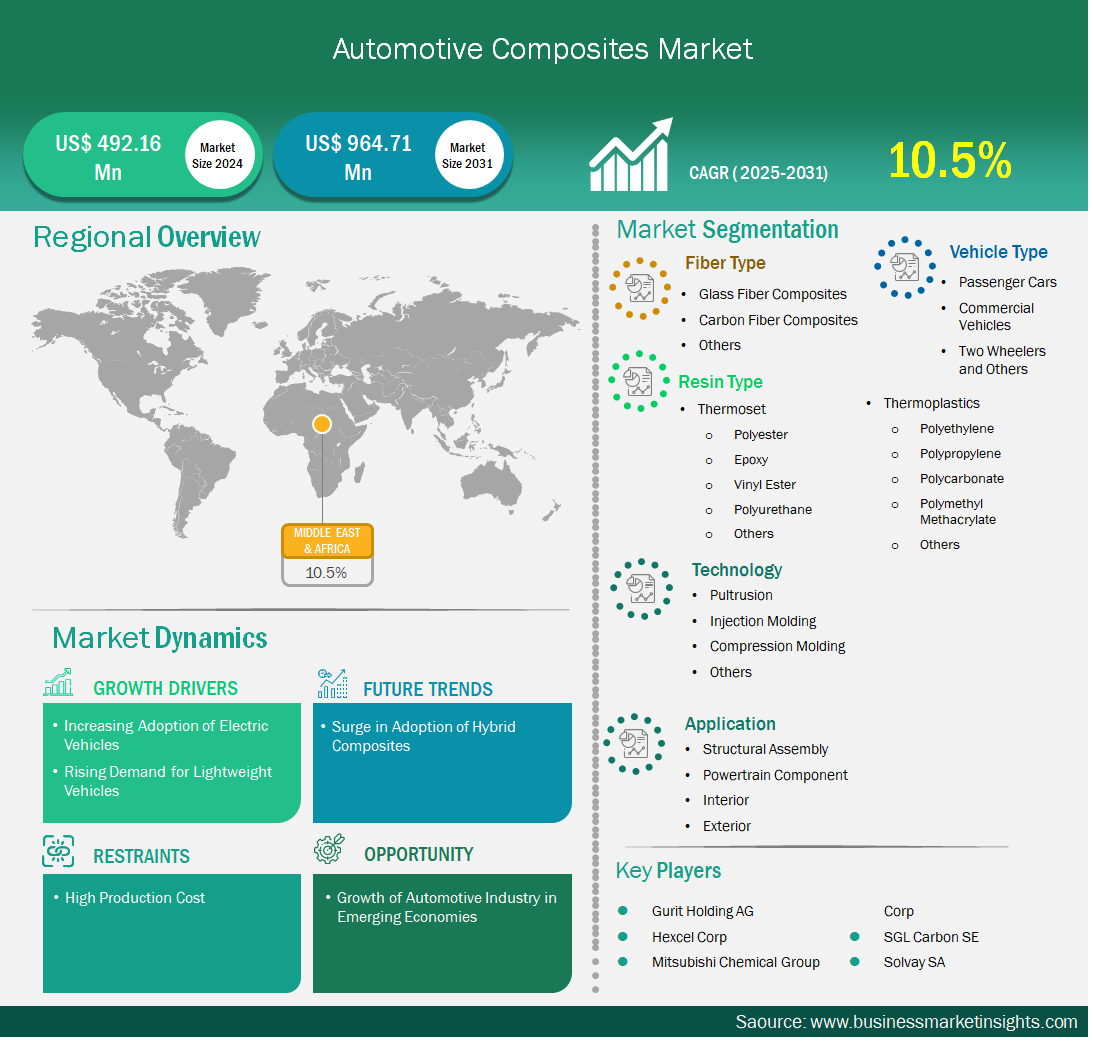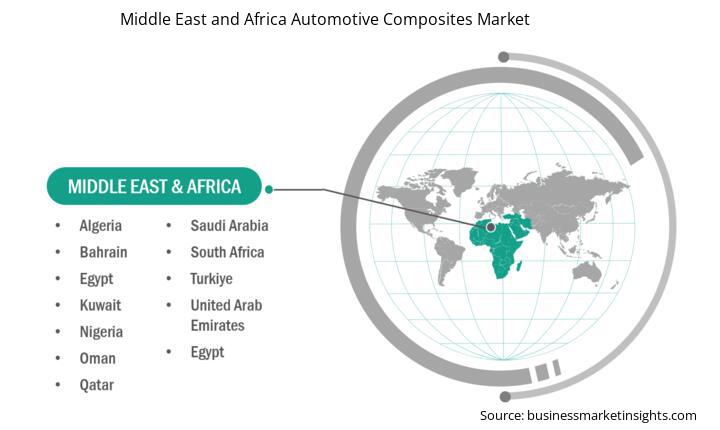Middle East and Africa Automotive Composites Market Outlook (2021-2031)
No. of Pages: 200 | Report Code: BMIPUB00031717 | Category: Chemicals and Materials
No. of Pages: 200 | Report Code: BMIPUB00031717 | Category: Chemicals and Materials
The Middle East and Africa Automotive Composites Market size is expected to reach US$ 964.71 million by 2031 from US$ 492.16 million in 2024. The market is estimated to record a CAGR of 10.5% from 2025 to 2031.
According to Fastener World Inc., in the Middle East, automotive industries in Saudi Arabia, the UAE, and Israel experienced sales growth of over 20%. Also, despite being smaller than other regions, Africa's production reached over a million units and experienced a 15% year-on-year growth in 2023. South Africa and Morocco are the primary producers of automobiles in the region, with over 600,000 and 500,000 vehicles, respectively, in 2023. Turkey also experienced a significant sales growth of over 55%, reaching nearly 1.3 million units. Therefore, the rise in sales of vehicles in the Middle East & Africa is expected to fuel the demand for automotive elastomers in the coming years.

Key segments that contributed to the derivation of the Middle East and Africa automotive composites market analysis are product type, resin type, technology, vehicle type, and application.
Elastomers are used in vehicle interior components such as seats, doors, airbags, and transmission belts, as well as exterior components such as front-end body panels and under the hood. These materials help vehicles endure extreme temperatures and perform in harsh desert climates. The rise in automotive sales in the Middle East & Africa creates a significant demand for elastomers. For instance, in September 2022, Renault Group Morocco announced that its two factories in Tangier and Casablanca, Morocco, produced 50,000 vehicles in 2022, a 15.3% increase over the production numbers in 2021. In the Middle East & Africa, the market is evolving due to the growing passenger vehicle production, increasing population, and rising middle-class income.
According to the International Trade Administration, the total vehicle production in South Africa increased from 446,210 units in 2020 to 510,000 units in 2022. South Africa launched the South Africa Automotive Masterplan (SAAM) 2021–2035 in 2021, aimed at producing 1.4 million vehicles, representing 1% of global vehicle production per annum by 2035. The country's seven original equipment manufacturers (OEMs) in the automotive sector invested ~US$ 460 million in 2021. South Africa's well-established automotive sector, which includes major global automakers, is shifting toward EVs, further boosting the use of lightweight materials. As the market for environmentally friendly vehicles expands, South Africa's automotive composites industry is poised to grow, supporting domestic and export demands.
Based on region, the Middle East and Africa automotive composites market is further segmented into South Africa, Saudi Arabia, UAE, Turkey, Qatar, Kuwait, Egypt, Bahrain, Oman, Nigeria, Algeria, and Rest of Middle East and Africa. Turkey recorded a significant market share in 2024.
The automotive composites market in Turkey is growing, driven by the country's strong automotive manufacturing sector and increasing demand for lightweight, fuel-efficient vehicles. Composites such as fiberglass, carbon fiber, and natural fibers are increasingly being adopted to enhance vehicle performance, reduce emissions, and improve fuel economy. As Turkey focuses on sustainability and environmental regulations, the shift toward EVs accelerates using lightweight materials to increase battery range and overall efficiency. With ongoing investments in automotive research and development, Turkey's automotive composites market is poised to expand, supporting both domestic production and export opportunities.
Gurit Holding AG, Hexcel Corp, Mitsubishi Chemical Group Corp, SGL Carbon SE, Solvay SA, Teijin Ltd, DuPont de Nemours In, Toray Industries Inc, Atlas Fibre, and Elaghmore Advisor LLP are among the key players operating in the market. These players adopt strategies such as expansion, product innovation, and mergers and acquisitions to stay competitive in the market and offer innovative products to their consumers.
The following methodology has been followed for the collection and analysis of data presented in this report:
The research process begins with comprehensive secondary research, utilizing both internal and external sources to gather qualitative and quantitative data for each market. Commonly referenced secondary research sources include, but are not limited to:
Note:
All financial data included in the Company Profiles section has been standardized to US$. For companies reporting in other currencies, figures have been converted to US$ using the relevant exchange rates for the corresponding year.
Business Market Insights conducts a significant number of primary interviews each year with industry stakeholders and experts to validate and analyze the data and gain valuable insights. These research interviews are designed to:
Primary research is conducted via email interactions and telephone interviews with industry experts across various markets, categories, segments, and sub-segments in different regions. Participants typically include:
| Report Attribute | Details |
|---|---|
| Market size in 2024 | US$ 492.16 Million |
| Market Size by 2031 | US$ 964.71 Million |
| CAGR (2025 - 2031) | 10.5% |
| Historical Data | 2021-2023 |
| Forecast period | 2025-2031 |
| Segments Covered |
By Fiber Type
|
| Regions and Countries Covered | Middle East and Africa
|
| Market leaders and key company profiles |
|

The Middle East and Africa Automotive Composites Market is valued at US$ 492.16 Million in 2024, it is projected to reach US$ 964.71 Million by 2031.
As per our report Middle East and Africa Automotive Composites Market, the market size is valued at US$ 492.16 Million in 2024, projecting it to reach US$ 964.71 Million by 2031. This translates to a CAGR of approximately 10.5% during the forecast period.
The Middle East and Africa Automotive Composites Market report typically cover these key segments-
The historic period, base year, and forecast period can vary slightly depending on the specific market research report. However, for the Middle East and Africa Automotive Composites Market report:
The Middle East and Africa Automotive Composites Market is populated by several key players, each contributing to its growth and innovation. Some of the major players include:
The Middle East and Africa Automotive Composites Market report is valuable for diverse stakeholders, including:
Essentially, anyone involved in or considering involvement in the Middle East and Africa Automotive Composites Market value chain can benefit from the information contained in a comprehensive market report.